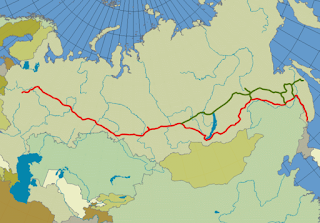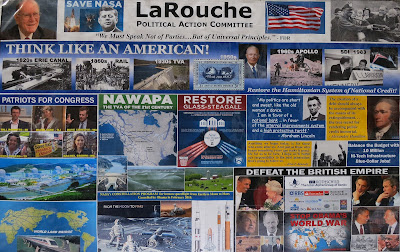In the United States, Lyndon LaRouche is widely dismissed as a wing-nut conspiracist — a guy who claims that Queen Elizabeth pushes drugs. But in Russia, LaRouchite ideology is taken seriously by high-ranking politicians and scholars, and is cross-pollinating with the ideas of Russian far rightists such as Aleksandr Dugin.
The LaRouchites’ wing-nut reputation actually masks a lot of their more dangerous politics and history. LaRouche, a former Trotskyist, founded the National Caucus of Labor Committees (NCLC) in 1969 as a Marxist organization, but in the 1970s transformed it into a fascist political cult with a unique ideology centered on grandiose, arcane conspiracy theories. By the 1980s, LaRouche’s followers had built an extensive network of organizations on several continents, dedicated to propaganda, fundraising, intelligence gathering, and political dirty tricks. (For details, see Dennis King’s 1989 book, Lyndon LaRouche and the New American Fascism, which is accessible online.) For several years, the LaRouchites had a friendly relationship with the Reagan administration and its security services, but illegal fundraising eventually got them in trouble, and LaRouche himself went to prison for fraud and conspiracy from 1989 to 1994. However, his organization rebounded by shifting to more “leftist” positions, with an emphasis on opposing U.S. military interventionism and international finance capital.
Having lost the U.S. government connections they enjoyed in the 1980s, the LaRouchites worked to expand their ties with political elites in other countries — above all, Russia. In recent years, the LaRouchites have increasingly emphasized the importance of Russia on the world stage, and have largely aligned themselves with President Vladimir Putin’s international policies, for example on the conflicts in Syria and Ukraine.
A recent article by Anton Shekhovtsov traces some of the story behind this new alignment:
“With the demise of the Soviet Union,… LaRouche became genuinely interested in Russia and its economy, arguing against adoption of Western liberal economic models by Russia. In 1992, the Schiller Institute for Science and Culture was established in Moscow as a Russian branch of the LaRouchite international Schiller Institute, and started publishing Russian translations of LaRouche’s essays.”
During the 1990s, LaRouche visited Russia and spoke at a number of academic meetings. His economic ideas sparked interest among some members of the elite who were unhappy with the laissez-faire policies that prevailed under then President Boris Yeltsin.
“LaRouche’s contacts in Russian academia and the Moscow-based Schiller Institute for Science and Culture actively promoted his ideas in Russia, and, since 1995, he was trying to exert direct influence on Russian policy-making in the economic sphere. Representatives of the Schiller Institute for Science and Culture presented LaRouche’s memorandum ‘Prospects for Russian Economic Revival’ at the State Duma, while later that year LaRouche himself appeared in the Russian parliament to present his report ‘The World Financial System and Problems of Economic Growth.’ His conspiracy-driven economic theories that denounced free trade and commended protectionism, as well as attacking the workings of the International Monetary Fund, stroke a chord with many a member of the Duma largely dominated by the anti-liberal and anti-democratic forces such as the Communist Party of the Russian Federation, Liberal-Democratic Party of Russia and other ultranationalists.”
Shekhovtsov’s article centers on LaRouche’s relationship with Sergey Glazyev, who in the early 1990s was minister of external economic relations (but resigned because of a disagreement with Yeltsin) and then a member of the State Duma, or parliament. Since 2012, Glazyev has been a prominent adviser to Russian President Vladimir Putin.
“During the 1990s, the LaRouchites praised Glazyev as ‘a leading economist of the opposition to Boris Yeltsin’s regime’ and published Glazyev’s interviews and articles in their weekly Executive Intelligence Review. In 1999, LaRouche published an English translation of Glazyev’s book Genocide: Russia and the New World Order in which the author exposed his theories about ‘the world oligarchy’ using ‘depopulation techniques developed by the fascists’ ‘to cleanse the economic space of Russia for international capital.’”
* * *
“Glazyev’s promotion of LaRouche and his ideas in Russia resulted in the latter’s growth in popularity as an opinion-maker and commentator on political and economic issues in Russia – a status that LaRouche could not enjoy in his home country where he has remained a fringe political figure.”
In some ways the LaRouchites’ current stance resembles that of Russian nationalists who combine support for Putin with romanticism about the Soviet Union. Although Shekhovtsov writes that “In the 1970-80s, the LaRouchites were highly critical of the Soviet Union and believed that it was controlled by the British oligarchs,” that’s not entirely true. Dennis King offers a fuller account:
“LaRouchian publications until the death of Leonid Brezhnev [in 1982] expressed an affection for hard-line Stalinism because of its no-nonsense attitude toward Zionists and other dissenters and its commitment to central economic planning. New Solidarity’s obituary on Brezhnev praised him as a ‘nation builder’ and avoided any mention of his invasions of Czechoslovakia and Afghanistan. Thereafter, as LaRouche became more heavily involved in supporting Star Wars and NATO, the NCLC line changed. Moscow became the ‘Third Rome,’ a center of unremitting Russian Orthodox evil. When Gorbachev took power, the LaRouchians said he was the Antichrist.”
As King details, from 1974 to about 1983 members of the LaRouche network also repeatedly met and shared information with KGB officers and other Soviet officials. The LaRouchites claimed that they served as “the ‘open channel’ through which the KGB could pass ‘policy-relevant’ information to the CIA, and vice versa.”
The LaRouchites don’t like to talk about this part of their own history nowadays, but they have nothing but praise for ex-KGB officer Vladimir Putin. In 2011, for example, LaRouche applauded the nomination of Putin (who was then serving as prime minister) to return to the office of president (which he had previously held in 2000-2008): “”This assertion of leadership sends a clear message of defiance against the British Empire’s divide-and-conquer games, and represents a major step forward toward a new Pacific-centered recovery program for the entire world.”
 |
| Map of the Trans-Siberian Railway, an early example of the kind of big infrastructure project the LaRouchites glorify. |
The LaRouchites like Putin not only because he has challenged the United States and European Union, but also because they see him as a kindred spirit on questions of national development. The LaRouchite program, for Russia and elsewhere, emphasizes a strong state role in society, classical culture and religion as the moral basis for politics, and big, high-tech infrastructure projects — notably a “Eurasian Land Bridge” transportation network — to drive economic recovery.
The Eurasian Land Bridge idea highlights the question: how much does LaRouchite fascism have in common with the politics of Aleksandr Dugin, which centers on the vision of a new Eurasian empire? In some ways the two are very different. While the LaRouchites wrap themselves in the mantle of science and rational humanism, Duginists call for Russian ethno-cultural rebirth in much more mystical terms. LaRouchite publications rarely mention Dugin, but a 2012 article in Executive Intelligence Review refers to his “gloomy Germanicism” with “a strong metaphysical component, but almost nothing by way of a coherent economic program.”
Yet both LaRouche and Dugin offer a deeply authoritarian, culturally elitist vision of society, and a conspiracist critique of international elites, while claiming to reject racism and antisemitism. Hearing LaRouche demonize Britain as the center of the global oligarchic conspiracy, it’s not a big jump to Dugin’s view of history as a secret geopolitical contest between the good land power (Eurasists) and the evil sea power (Atlantists). And, above all, both LaRouche and Dugin see Russia as the key hope for humanity today.
So it’s not a big surprise that Sergey Glazyev is on friendly terms with both the LaRouche network and Dugin. Glazyev participated in the founding conference of Dugin’s Eurasia Party in 2002 before helping to found a separate far right party, Rodina (Motherland), the following year. Glazyev and Dugin are both members of the Izborsky Club, an influential far right think tank that proclaims Peter the Great and Josef Stalin as the main heroes of Russian history. And one of Glazyev’s main jobs for Putin has been to negotiate greater economic integration of former Soviet republics under the rubric of a Eurasian Union — a project dear to both Dugin and LaRouche.
Glazyev isn’t the only link connecting LaRouche and Dugin. Another is Nataliya Vitrenko, leader of the Progressive Socialist Party of Ukraine. Vitrenko is a member of Supreme Council of Dugin’s International Eurasian Movement, which has branches in 22 countries. But she is also a close ally of the LaRouche network, who has for years promoted LaRouche’s ideas, addressed LaRouchite-sponsored meetings and conferences, and received favorable coverage in LaRouchite publications. In February 2014, for example, Executive Intelligence Review published a statement by Vitrenko under the headline “U.S.A. and EU, With Ukrainian Terrorists, Establish Nazi Regime.”
These indirect ties between LaRouchites and Duginists in Russia are particularly striking given how politically isolated the LaRouchites are in the U.S. — even from other far rightists. This doesn’t mean the two movements are likely to join forces directly. Differences of ideology and political culture — not to mention their leaders’ egos — stand in the way of an actual alliance. But figures such as Glazyev and Vitrenko may serve as conduits — or “open channels” in the LaRouchites’ spy-novel terminology — that promote a sharing of ideas and information between the two. Glazyev and others in the political elite may also borrow ideological and programmatic elements from both movements to make something stronger. This is a level of influence most wing-nuts can only dream of.
Image credits:
LaRouchePAC poster collage – By Racconish (Own work) [CC BY-SA 3.0], via Wikimedia Commons.
Trans-Siberian Railway map – By User:Stefan Kühn (Own work) [GFDL, CC-BY-SA-3.0 or CC BY-SA 2.5-2.0-1.0], via Wikimedia Commons.
